Findings are based on a working paper by Robert Wagmiller and Robert Adelman, Childhood and Intergenerational Poverty: The Long-term Consequences of Growing Up Poor commissioned by NCCP. This brief is designed to be a companion piece to this document. The analysis uses data from the Panel Study of Income Dynamics (PSID), a longitudinal data set that follows children as they advance through childhood and into adulthood, and employs a strategy developed by Grieger, Danziger, and Schoeni* to construct poverty indicators comparable to official Census Bureau estimates. In this analysis, childhood refers to the years between birth and age 15; the paper provides more details about findings, data sources and methodology.
* Grieger, Lloyd D.; Danziger, Sheldon; Schoeni, Robert F. 2007. Estimating and Benchmarking the Trend in the Poverty Rate from the Panel Study of Income Dynamics. Ann Arbor, MI: PSID Technical Series Paper #07-03.
Introduction
The promise of the American Dream is that in our society, anyone can succeed with hard work and persistence. Even in the current economic downturn, the majority of Americans (72 percent) believe that it is possible to start out poor, work hard, and become wealthy. But does this promise hold true for America’s children? How common is it for people who spend part of their childhood living in poverty to experience poverty as adults? How does this vary by how much time children spend living in poverty? And does it vary by race?
Economic mobility, the ability to move up or down the economic ladder during one’s lifetime and across generations, is central to the ideal of the American Dream. But recent research finds that there are limitations to mobility in the United States. For example, one study of families across generations finds that one’s economic position is strongly influenced by that of one’s parents: 42 percent of children born to parents in the bottom fifth of the economic distribution remain in the bottom as adults and another 23 percent rise only to the second fifth, while 39 percent of children born to parents at the top of the income distribution remain at the top, with another 23 percent moving to the second fifth.
This paper focuses on the lower end of the earnings spectrum and highlights findings from a working paper commissioned by the National Center for Children in Poverty (NCCP). In particular, we report how common it is for children to experience poverty throughout the course of childhood – defined as the years from birth to age 15 – and how that relates to the likelihood that they will be poor in young and middle adulthood.
How many children live in poverty today?
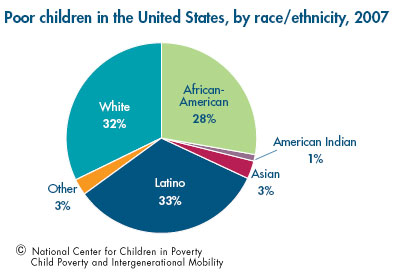
Today, 18 percent of children in the United States live in poverty (13 million children), a figure that is expected to rise given the current economic downturn. For 2009, the federal poverty level is $22,050 for a family of four. Research shows that, on average, families need an income of about twice that to cover their basic expenses; under this measure, 39 percent of children live in lowincome families.
Although the analysis in this brief includes only white children and African-American children (due to data constraints), Latino children represent the largest group of poor children.
Child poverty and economic hardship can have significant consequences for children’s development and life chances. Growing up in poverty can be harmful to children’s cognitive development and ability to succeed in school, to their social and emotional well-being, and to their health. Children who experience hardship when they are young and children who live in persistent and severe poverty are at the greatest risk. Moreover, child poverty costs our society an estimated $500 billion a year in lost productivity and increased spending on health care and the criminal justice system.
We find that although only a small share of children experience persistent, chronic poverty, children who do are much more likely to be poor as adults. We also find that African-American children are more likely than white children to experience poverty, and even when they spend similar amounts of time living in poverty during childhood, they are more likely to be poor as adults. We conclude by making policy recommendations for improving the life chances of children who grow up in poverty by both increasing family income in the short-term and mitigating the impact of poverty on child outcomes.
How common is it for children to experience poverty at some point during their childhood?
About a third of children experience poverty at some point during childhood; most of these children do not experience chronic, persistent poverty.
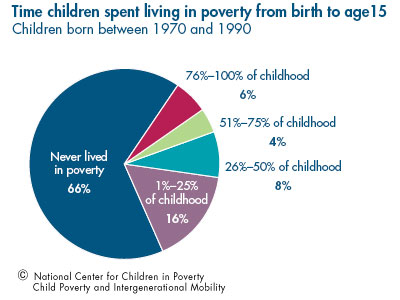
- 35 percent of children (born between 1970 and 1990) had experienced poverty by the time they reached age 15.
- Of children who experienced poverty, most (69 percent) were poor for less than half of their childhood.
- A small portion of children who experienced poverty lived in persistent poverty: one in 10 children spent at least half of their childhood living in poverty and 6 percent of children were poor for three quarters or more of those years.
African-American children are significantly more likely than white children to experience poverty.
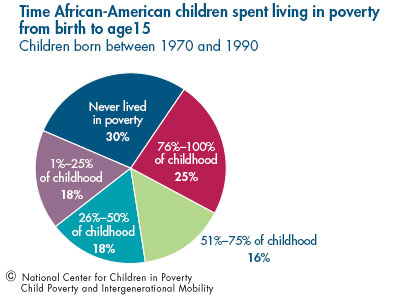
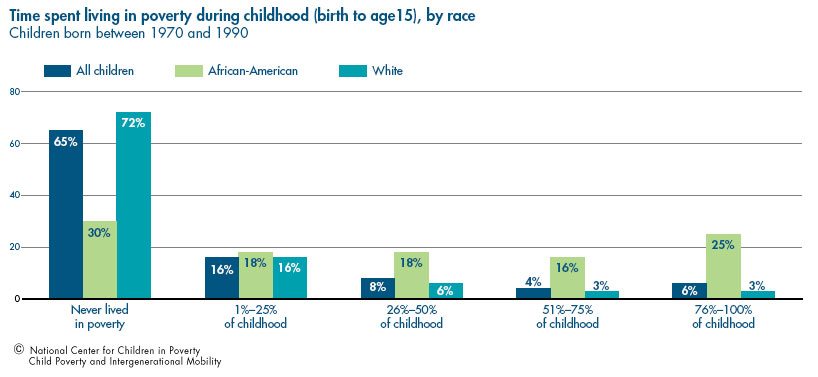
- Less than one third (30 percent) of African-American children never lived in poverty, compared to 72 percent of white children.
- 41 percent of African-American children lived in poverty for more than half of their childhood, compared to six percent of white children.
- 25 percent of African-American children lived in poverty for more than three-quarters of their childhood, compared to three percent of white children.
Are children who experience poverty more likely to be poor as adults?
Those who experience poverty in childhood are substantially more likely to be poor as adults than those who have not.
- Only a tiny fraction of adults who never experienced poverty during childhood were poor in their 20s and 30s.
- Among adults who did experience poverty as children, on the other hand, about 20 percent were poor in young adulthood (at ages 20 and 25) and 13-14 percent were poor in middle adulthood (at ages 35 and 30, respectively).
The risks associated with persistent poverty are particularly severe: the small share of children who spend more than half of their childhood in poverty are much more likely to be poor as adults.
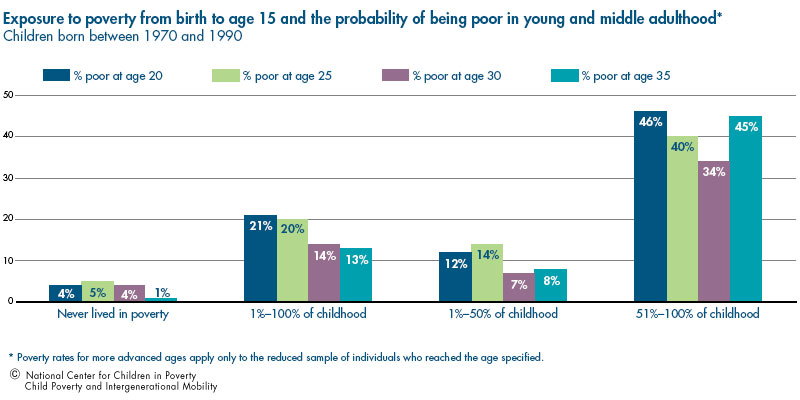
- Among 20-year-olds who spent some time in poverty as children, 12 percent of those who spent less than half of their childhood in poverty were poor, compared to 46 percent of those who were poor for more than half of their childhood.
- The same pattern was found for middle adulthood: poverty rates among 30- and 35-year-olds who were poor for some – but less than half – of their childhood range from seven to eight percent, while the rates for those who were poor during the majority of their childhood were several times higher.
African-American adults who experience poverty in childhood are substantially more likely to be poor through early and middle adulthood, compared to whites who experience similar levels of poverty as children.
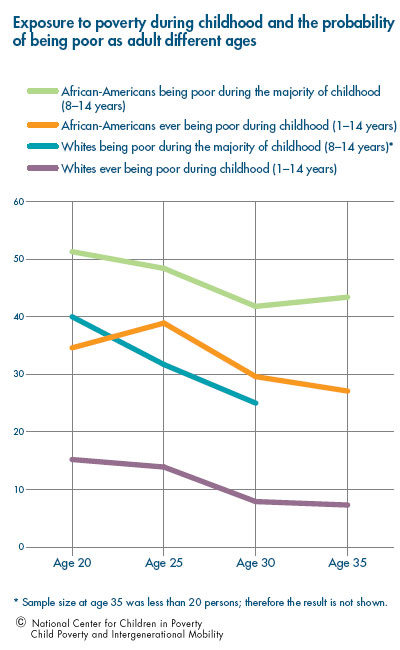
- Among African-American adults who lived in poverty for more than half of their childhood, 42 percent were poor at age 30, compared to 25 percent of whites.
- Low to moderate childhood poverty appears to have a particularly disproportionate impact on African-American adults: among 30-year-olds who spent less than half of their childhood in poverty (but at least one year), 19 percent of African-American adults were poor, compared to just five percent of whites.
Conclusion and Policy Recommendations
The findings in this brief are consistent with a wide body of research documenting limited economic mobility in the United States and the significant risks associated with child poverty. Children who grow up in poverty are more likely to be poor as adults, while those who grow up in more affluent families are more likely to be affluent later in life. While even a few years in poverty can have a significant impact on children’s economic trajectories, the risks are particularly severe for the small number who experience many years of poverty. Finally, this study highlights the country’s persistent racial disparities. For African-American children, not only is poverty far more common than among whites, the experience of childhood poverty is associated with a far greater chance of being poor as an adult.
To break the cycle of poverty and improve the odds for all of our country’s children, we need a two-generation approach that lifts family income in the short-term, while also mitigating the impact of poverty on children’s life chances. First, children are poor because their parents are poor, and it is critical that we address this problem head-on with policies and programs that support work and increase family income. This includes making work pay with policies that promote high-quality jobs, particularly in disadvantaged communities, as well as with supports that allow parents to afford basic family necessities when working for low wages. It also includes programs that reduce barriers to employment among families struggling with, for example, limited educational attainment, language barriers, substance abuse or other mental or physical health needs. And particularly in a period of rising unemployment, ensuring access to unemployment insurance and other supports for the jobless is critical.
At the same time, we need to address the impact of poverty on children’s health and development. This means ensuring that all young children have access to high-quality early care and education and health and mental health care, regardless of income. It also means improving our public schools and providing supports to at-risk youth. Finally, asset disparities between white and African-American families are even greater than income disparities, and there is compelling evidence that asset-development policies, such as Children’s Development Accounts, can play an important role in promoting low-income children’s economic mobility.
With the economic crisis pushing more families with children to be economically vulnerable, addressing both the incidence and impact of child poverty is more critical than ever. The bottom line is that to make the American Dream a reality for all – and to ensure that our country has a productive and competitive workforce in the years to come – we need to invest in our families and children today.
Endnotes
1. http://www.nytimes.com/2009/05/08/us/08dreampoll.html?hp
2. Sawhill, Isabel V. 2008. “Overview” in Getting Ahead or Losing Ground: Economic Mobility in America. Washington, DC: Brookings Institution, Economic Mobility Project.
3. Isaacs, Julia B. 2007. Economic Mobility of Families Across Generations. Washington, DC: Brookings Institution, Economic Mobility Project.
4. For all data, findings pertain to children born between 1970 and 1990. For more information about data sources and methodology, see the full working paper: Wagmiller, Robert L.; Adelman, Robert M. 2009. Childhood and Intergenerational Poverty: The Long-term Consequences of Growing Up Poor. New York, NY: National Center for Children in Poverty, Columbia University, Mailman School of Public Health.
5. Holzer, Harry; Schazenbach, Diane Whitmore; Duncan, Greg J.; Ludwig, Jens. 2007. The Economic Costs of Poverty: Subsequent Effects of Children Growing up Poor. Washington, DC: Center for American Progress.
6. Parrott, Sharon. 2008. Recession Could Cause Large Increases in Poverty and Push Millions into Deep Poverty. Washington, DC: Center on Budget and Policy Priorities. Mishel, Lawrence. 2009. Rising Unemployment Could Leave Half of African American Children in Poverty. Washington, DC: Economic Policy Institute.
7. Fass, Sarah; Cauthen, Nancy K. 2008. Who Are America’s Poor Children: The Official Story. New York, NY: National Center for Children in Poverty, Columbia University, Mailman School of Public Health. For more on what it costs to make ends meet, see: Dinan, Kinsey Alden. 2009. Budgeting for Basic Needs: A Struggle for Working Families. New York, NY: National Center for Children in Poverty, Columbia University, Mailman School of Public Health.
8. Throughout this brief, childhood refers to the years between birth and age 15.
9. See Table 1 in Wagmiller & Adelman (2009) in endnote 4.
10. For more on supports that make work pay for low-wage workers, see NCCP’s Making Work Supports Work project.
11. For more on Improving the Odds for Young Children, see the project page.
12. For more on Improving the Odds for Adolescents, see the project page.
13. Aratani, Yumiko; Chau, Michelle. Forthcoming. Asset Poverty and Debt among Families with Children in the United States. New York, NY: National Center for Children in Poverty, Columbia University, Mailman School of Public Health.
14. Gavin, Brigette and Carl Rist (CFED); Kinsey Alden Dinan (NCCP). 2009. Presents at the Creation: The Importance of Asset- Building in the Early Childhood Years. Washington, DC: CFED.
